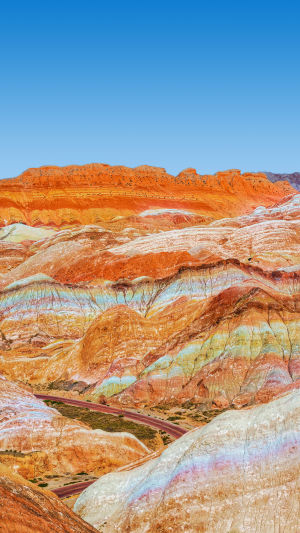Danxia landforms are a unique type of geological formation characterized by continuous erosion, transport, abrasion, and weathering of red sand conglomerates along vertical joints under the influence of water.
The existence of a distinctive red layer is the foundation of Danxia landforms. This "red layer" refers to the red rock system deposited during the Jurassic to Cenozoic Quaternary period, known as "red gravels."
Horizontal tectonic landforms are composed mainly of Tertiary thick-layered red sand conglomerate with a predominantly flat or near-horizontal composition. These formations undergo intense erosion, dissolution, and gravitational collapse, resulting in flat mountaintops, cliffs, and isolated tower-like terrain.
Several conditions contribute to the development of Danxia landforms:
Material Composition: The red gravel rock system serves as the fundamental material for the formation of Danxia landforms. Different lithological and petrographic characteristics determine specific development patterns and landscape formation types.
Geological Formations: The spatial patterns and mountain morphology of Danxia landforms are influenced by the underlying geological formations. The regional geological structure controls the formation and spreading of red-layer basins, while tectonic lines within the basin dictate the pattern and basic shape of mountain blocks.
Additionally, rock production influences the slope characteristics of Danxia landforms, while subsequent crustal uplift restricts their development process and provides conditions for continued erosion by external forces.
Internal and External Dynamics: Both internal and external dynamic systems play significant roles in the formation and development of Danxia landforms. Internal dynamics are primarily controlled by geological and tectonic factors.
For instance, the regional geological structure influences the formation and expansion of red-layer basins, while tectonic lines within the basin shape the overall pattern and form of mountain blocks.
Rock production also determines the slope characteristics of Danxia landforms. Conversely, later crustal uplift constrains their development process, setting the stage for subsequent erosion by external forces.
External driving forces include water erosion, weathering, and gravity. Among these, flowing water erosion is the primary driving force, as it undermines and erodes the red layer, creating distinctive erosion landscapes.
Additionally, the striking impact of rainwater and runoff on exposed rocks contributes to surface destruction and transformation. Weathering is a gradual but consistent force, as the strong kinetic energy of wind erodes rocks, making them more susceptible to breakage and flaking.
Gravity manifests itself as abrupt changes and plays a crucial role in the formation of Danxia's cliff slopes. Overhanging rock bodies often collapse along primary tectonic joints or unloading joints under the influence of gravity, directly contributing to the formation of these unique landforms.
The evolution of Danxia landforms begins with the uplift of red-layer basins. External forces such as flowing water, weathering, and gravity widen the valleys, cause cliff walls to collapse and recede, and gradually reduce the summit area.
Consequently, the original mountain body retreats, leaving behind fortress-like residual peaks or isolated stone pillars. Danxia landforms are primarily found in various regions of China, as well as in the western United States, Central Europe, and Australia.
However, China boasts the most extensive distribution of Danxia landforms, with occurrences in tropical and subtropical humid zones, temperate humid and semi-humid zones, semi-arid and arid zones, as well as the alpine zone of the Qinghai-Tibet Plateau.





